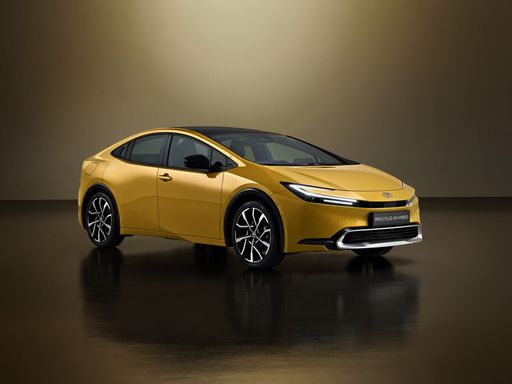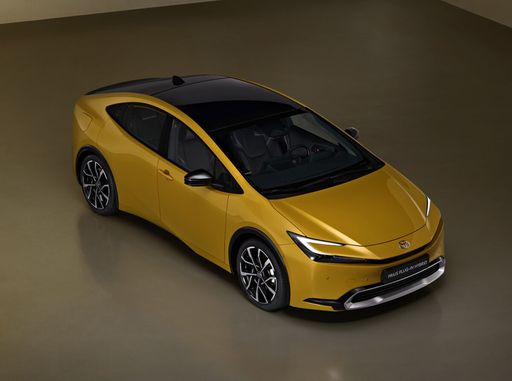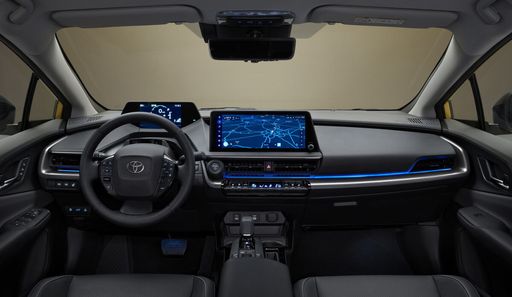SERES 3 VS Toyota Prius – Specs, Efficiency & Price Comparison
Which model is the better choice – the SERES 3 or the Toyota Prius? We compare performance (163 HP vs 223 HP), boot capacity (0 L vs 284 L), efficiency (18 kWh vs 0.50 L), and of course, the price (31600 £ vs 39400 £).
Find out now which car fits your needs better!
The SERES 3 (SUV) is powered by a Electric engine and comes with a Automatic transmission. In comparison, the Toyota Prius (Hatchback) features a Plugin Hybrid engine and a Automatic gearbox.
When it comes to boot capacity, the SERES 3 offers 0 L, while the Toyota Prius provides 284 L – depending on what matters most to you. If you’re looking for more power, you’ll need to decide whether the 163 HP of the SERES 3 or the 223 HP of the Toyota Prius suits your needs better.
There are also differences in efficiency: 18 kWh vs 0.50 L. In terms of price, the SERES 3 starts at 31600 £, while the Toyota Prius is available from 39400 £.
Compare all the key specs now and find out which model fits your lifestyle best!
SERES 3
The SERES 3 marks an intriguing entry into the electric vehicle market, distinguished by its sleek design and advanced technology features. This compact SUV offers a commendable driving experience with its smooth handling and quick acceleration, making it a strong contender in urban environments. Additionally, the SERES 3 boasts a well-equipped interior, providing both comfort and connectivity for modern drivers.
detailsToyota Prius
The Toyota Prius stands as a pioneer in the realm of hybrid vehicles, offering an eco-friendly driving alternative with its innovative technology. Its aerodynamic design and comfortable interior make it a practical choice for those looking to reduce their carbon footprint without sacrificing style. Additionally, the Prius boasts a reputation for reliability and efficiency, contributing to its lasting popularity among environmentally conscious drivers.
details @ Toyota
@ Toyota
 @ Toyota
@ Toyota
 @ Toyota
@ Toyota
 @ Toyota
@ Toyota

|
|
|
|
|
Costs and Consumption |
|
|---|---|
|
Price
31600 £
|
Price
39400 - 45800 £
|
|
Consumption L/100km
-
|
Consumption L/100km
0.5 - 0.7 L
|
|
Consumption kWh/100km
18 kWh
|
Consumption kWh/100km
-
|
|
Electric Range
301 km
|
Electric Range
72 - 86 km
|
|
Battery Capacity
-
|
Battery Capacity
-
|
|
co2
0 g/km
|
co2
12 - 17 g/km
|
|
Fuel tank capacity
-
|
Fuel tank capacity
40 L
|
Dimensions and Body |
|
|---|---|
|
Body Type
SUV
|
Body Type
Hatchback
|
|
Seats
5
|
Seats
5
|
|
Doors
5
|
Doors
5
|
|
Curb weight
1765 kg
|
Curb weight
1620 - 1630 kg
|
|
Trunk capacity
0 L
|
Trunk capacity
284 L
|
|
Length
4385 mm
|
Length
4599 mm
|
|
Width
1850 mm
|
Width
1782 mm
|
|
Height
1650 mm
|
Height
1470 mm
|
|
Payload
300 kg
|
Payload
365 - 375 kg
|
Engine and Performance |
|
|---|---|
|
Engine Type
Electric
|
Engine Type
Plugin Hybrid
|
|
Transmission
Automatic
|
Transmission
Automatic
|
|
Transmission Detail
-
|
Transmission Detail
-
|
|
Drive Type
Front-Wheel Drive
|
Drive Type
Front-Wheel Drive
|
|
Power HP
163 HP
|
Power HP
223 HP
|
|
Acceleration 0-100km/h
9.90 s
|
Acceleration 0-100km/h
6.80 s
|
|
Max Speed
155 km/h
|
Max Speed
177 km/h
|
|
Torque
300 Nm
|
Torque
-
|
|
Number of Cylinders
-
|
Number of Cylinders
4
|
|
Power kW
120 kW
|
Power kW
164 kW
|
|
Engine capacity
-
|
Engine capacity
1998 cm3
|
General |
|
|---|---|
|
Model Year
2020
|
Model Year
2023
|
|
CO2 Efficiency Class
A
|
CO2 Efficiency Class
B
|
|
Brand
SERES
|
Brand
Toyota
|
SERES 3
Introducing the SERES 3: A Modern Marvel in Electric SUVs
The automotive world has witnessed a significant shift towards sustainable mobility, and the SERES 3 stands out as a compelling contender in the electric SUV segment. Crafted with precision and innovation, the SERES 3 is designed to meet the needs of environmentally conscious drivers without compromising on performance or style.
Power and Performance: Electric Precision
At the heart of the SERES 3 lies a robust electric motor that delivers an impressive 163 PS (120 kW), providing ample power for an exhilarating drive. With a torque of 300 Nm, the SERES 3 accelerates from 0 to 100 km/h in just 9.9 seconds, demonstrating its ability to merge swiftly into highway traffic or navigate city streets with ease.
Efficiency and Range: A Sustainable Drive
The SERES 3 boasts an efficient energy consumption of 18 kWh per 100 km, making it a cost-effective choice for daily commuting and long drives alike. With an electric range of up to 301 kilometres, range anxiety becomes a thing of the past, allowing drivers to explore the open road with confidence.
Design and Comfort: Embrace Modern Elegance
The SERES 3 is not just about performance; it also features a sleek and modern design. Its dimensions, measuring 4385 mm in length, 1850 mm in width, and 1650 mm in height, provide a spacious interior that comfortably accommodates up to five passengers. Whether you’re tackling an urban commute or embarking on a road trip, the SERES 3 ensures a comfortable and enjoyable ride.
Safety and Technology: Innovative Features
Equipped with advanced technological features, the SERES 3 enhances both safety and convenience. The automatic transmission with a reduction gearbox simplifies driving, while the CO2 efficiency class A rating ensures that your journey is as environmentally friendly as possible, with zero direct emissions.
Conclusion: The Future of Driving
The SERES 3 represents a harmonious blend of performance, design, and sustainability. Its entry into the market signifies a step forward in the evolution of electric vehicles, offering an attractive option for those looking to reduce their environmental impact without sacrificing the joy of driving. With its competitive price point and impressive specifications, the SERES 3 is set to make a lasting impression.
Toyota Prius
The All-New Toyota Prius: Revolutionising Efficiency and Performance
The Toyota Prius, a name synonymous with hybrid innovation, has once again shown why it remains at the forefront of eco-friendly automotive technology. The latest models have enhanced technical features and innovations, setting new standards for efficiency and driving experience.
Hybrid Performance: A Leap Forward
The latest Prius models employ a sophisticated 2.0 litre Plug-in Hybrid system that flawlessly melds petrol and electric power. With a power output of 223 PS, it propels the Prius with impressive dynamism, reaching 0-100 km/h in just 6.8 seconds. This performance-oriented aspect of the Prius does not compromise on efficiency, with an astonishing fuel consumption ranging from 0.5 to 0.7 L/100km.
Electric Range and Efficiency
One of the key highlights of the new Prius is its substantial electric-only range. Depending on the variant, it can travel between 72 to 86 km on electric power alone, making it an ideal choice for urban commutes where zero emissions are preferred. The hybrid system's CO2 emissions are remarkably low, between 12 and 17 g/km, contributing to its CO2 Efficiency Class B rating.
Engineering Excellence with CVT
The Prius is equipped with a state-of-the-art Continuously Variable Transmission (CVT), ensuring a smooth and efficient drive. This advanced transmission supports the front-wheel-drive layout, delivering power seamlessly and enhancing driving pleasure without sacrificing fuel economy.
Stylish Design and Comfort
Designed as a sleek five-door hatchback, the Prius offers a comfortable and spacious interior with seating for five passengers. It measures 4599 mm in length, 1782 mm in width, and 1470 mm in height, offering a practical balance of size and comfort. The boot space, while tailored for the hybrid battery, still provides a decent 284 litres of storage.
Cost Efficiency
The running costs of the Prius are competitive, with monthly expenses estimated between €1064 and €1188, and cost per kilometre ranging from 42.6 to 47.5 cents. Its efficient design results in a maximum speed of 177 km/h and a practical fuel tank size of 40 litres, ensuring less frequent stops on longer journeys.
Conclusion: The Prius Legacy Continues
The Toyota Prius continues to lead by example in the realm of hybrid technology. Combining impressive power with unmatched efficiency and a sophisticated driving experience, it is clear that the Prius remains a compelling choice for the environmentally conscious driver. Its innovative features and favourable cost metrics only bolster its appeal in the modern automotive landscape.
The prices and data displayed are estimates based on German list prices and may vary by country. This information is not legally binding.
